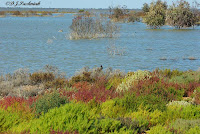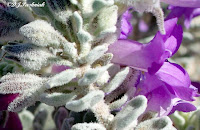This Black-faced Woodswallow (Artamus cinereus) was sitting in the top of a small tree. This was a new bird for me although we see both White-breasted and Dusky Woodswallows down here on the coast.
 This Diamond Dove (Geopelia cuneata) was also a new bird for me. We see plenty of Peaceful Doves here on the coast which are a similar size to the Diamond Dove.
This Diamond Dove (Geopelia cuneata) was also a new bird for me. We see plenty of Peaceful Doves here on the coast which are a similar size to the Diamond Dove. I did not have much luck with the ducks I tried to photograph. Either they were too far away for good photos or else they took off very fast when we got close.
I did not have much luck with the ducks I tried to photograph. Either they were too far away for good photos or else they took off very fast when we got close.These Pink-eared Ducks (Malacorhynchus membranaceus) flew off from behind some bushes but the in-flight photo is enough to show the zebra flanks, black patch around the eye, and the leathery flap at the end of the bill.
 These Plumed Whistling-Ducks (Dendrocygna eytoni) were on Cardenyabba Swamp in the late afternoon when the light had almost gone.
These Plumed Whistling-Ducks (Dendrocygna eytoni) were on Cardenyabba Swamp in the late afternoon when the light had almost gone.
 Finally a nest of the Wedge-tailed Eagle (Aquila audax) which Toni Sherwin showed me on Kilcowera station. The eagle flew off as we approached and stayed away! We also saw a number of these eagles on the side of the road but they all flew off as we approached.
Finally a nest of the Wedge-tailed Eagle (Aquila audax) which Toni Sherwin showed me on Kilcowera station. The eagle flew off as we approached and stayed away! We also saw a number of these eagles on the side of the road but they all flew off as we approached.












































